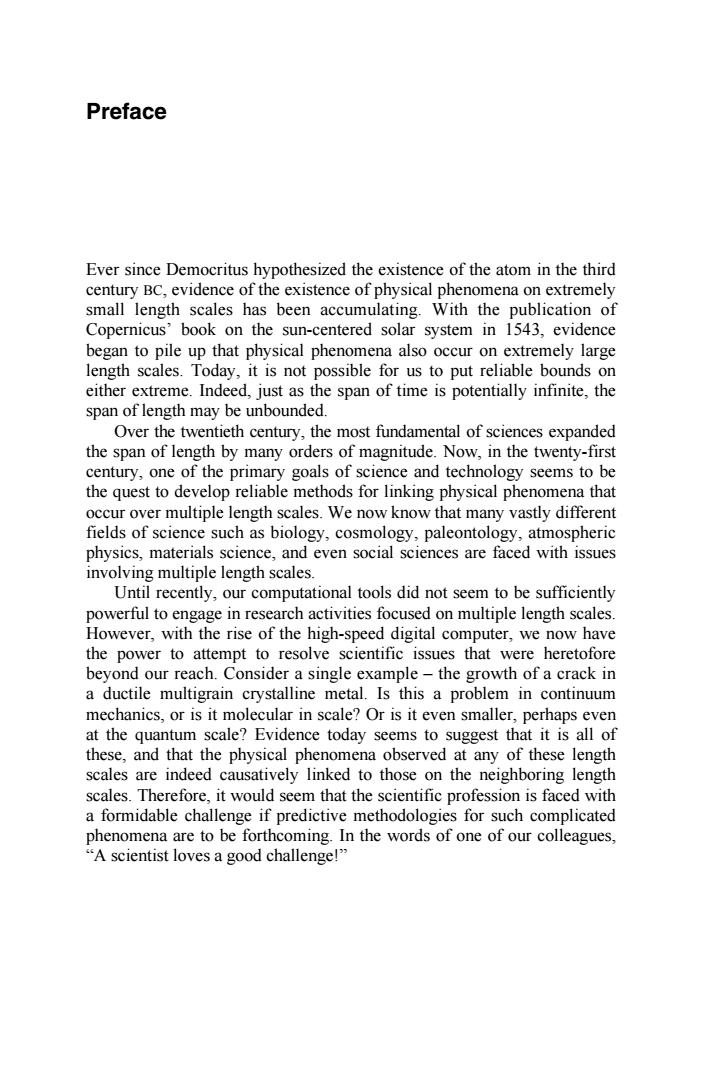正在加载图片...

Preface Ever since Democritus hypothesized the existence of the atom in the third century BC,evidence of the existence of physical phenomena on extremely small length scales has been accumulating.With the publication of Copernicus'book on the sun-centered solar system in 1543,evidence began to pile up that physical phenomena also occur on extremely large length scales.Today,it is not possible for us to put reliable bounds on either extreme.Indeed,just as the span of time is potentially infinite,the span of length may be unbounded. Over the twentieth century,the most fundamental of sciences expanded the span of length by many orders of magnitude.Now,in the twenty-first century,one of the primary goals of science and technology seems to be the quest to develop reliable methods for linking physical phenomena that occur over multiple length scales.We now know that many vastly different fields of science such as biology,cosmology,paleontology,atmospheric physics,materials science,and even social sciences are faced with issues involving multiple length scales. Until recently,our computational tools did not seem to be sufficiently powerful to engage in research activities focused on multiple length scales However,with the rise of the high-speed digital computer,we now have the power to attempt to resolve scientific issues that were heretofore beyond our reach.Consider a single example-the growth of a crack in a ductile multigrain crystalline metal.Is this a problem in continuum mechanics,or is it molecular in scale?Or is it even smaller,perhaps even at the quantum scale?Evidence today seems to suggest that it is all of these,and that the physical phenomena observed at any of these length scales are indeed causatively linked to those on the neighboring length scales.Therefore,it would seem that the scientific profession is faced with a formidable challenge if predictive methodologies for such complicated phenomena are to be forthcoming.In the words of one of our colleagues, "A scientist loves a good challenge!"Ever since Democritus hypothesized the existence of the atom in the third century BC, evidence of the existence of physical phenomena on extremely small length scales has been accumulating. With the publication of Copernicus’ book on the sun-centered solar system in 1543, evidence began to pile up that physical phenomena also occur on extremely large length scales. Today, it is not possible for us to put reliable bounds on either extreme. Indeed, just as the span of time is potentially infinite, the span of length may be unbounded. Over the twentieth century, the most fundamental of sciences expanded the span of length by many orders of magnitude. Now, in the twenty-first century, one of the primary goals of science and technology seems to be the quest to develop reliable methods for linking physical phenomena that occur over multiple length scales. We now know that many vastly different fields of science such as biology, cosmology, paleontology, atmospheric physics, materials science, and even social sciences are faced with issues involving multiple length scales. Until recently, our computational tools did not seem to be sufficiently powerful to engage in research activities focused on multiple length scales. However, with the rise of the high-speed digital computer, we now have the power to attempt to resolve scientific issues that were heretofore beyond our reach. Consider a single example – the growth of a crack in a ductile multigrain crystalline metal. Is this a problem in continuum mechanics, or is it molecular in scale? Or is it even smaller, perhaps even at the quantum scale? Evidence today seems to suggest that it is all of these, and that the physical phenomena observed at any of these length scales are indeed causatively linked to those on the neighboring length scales. Therefore, it would seem that the scientific profession is faced with a formidable challenge if predictive methodologies for such complicated phenomena are to be forthcoming. In the words of one of our colleagues, “A scientist loves a good challenge!” Preface